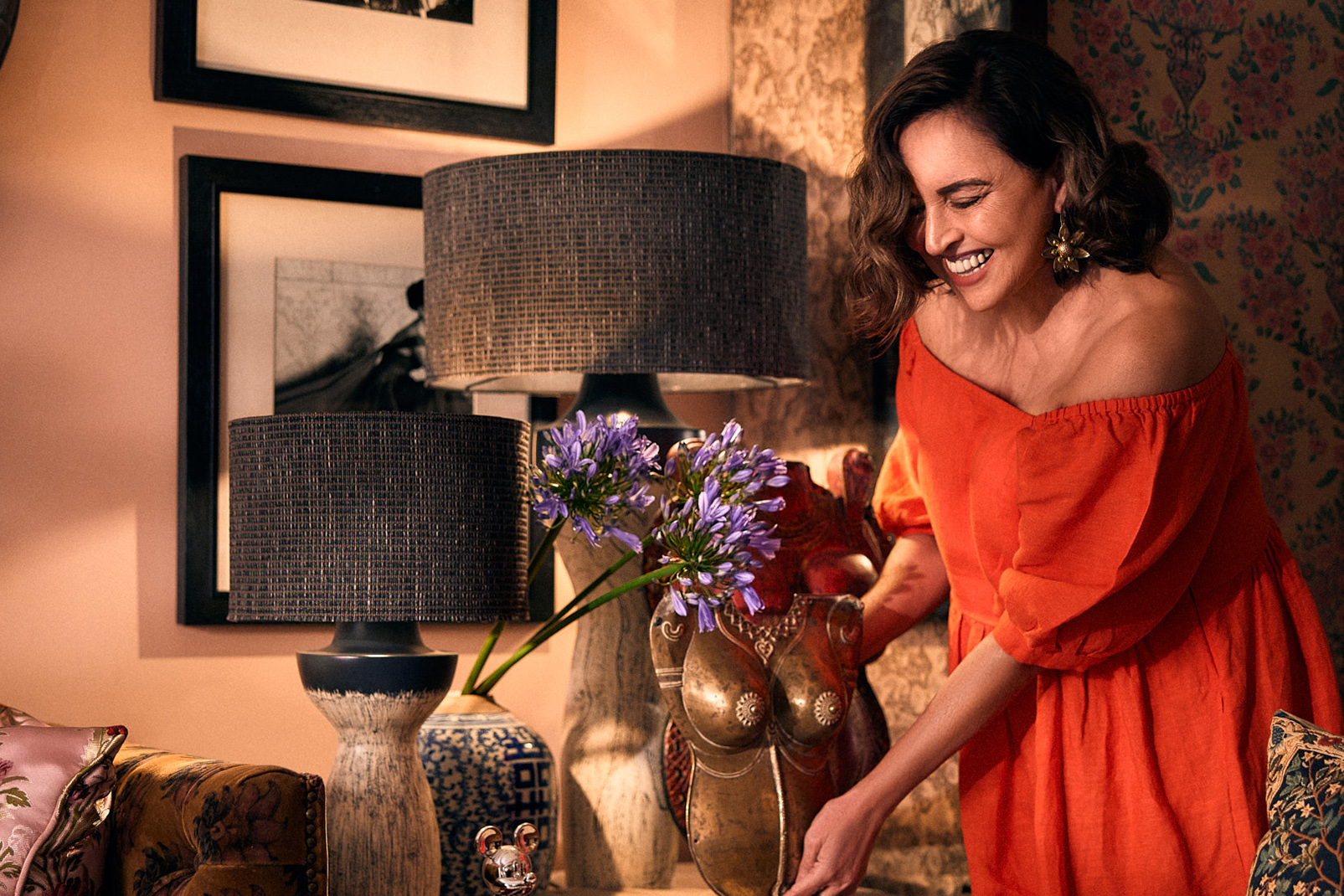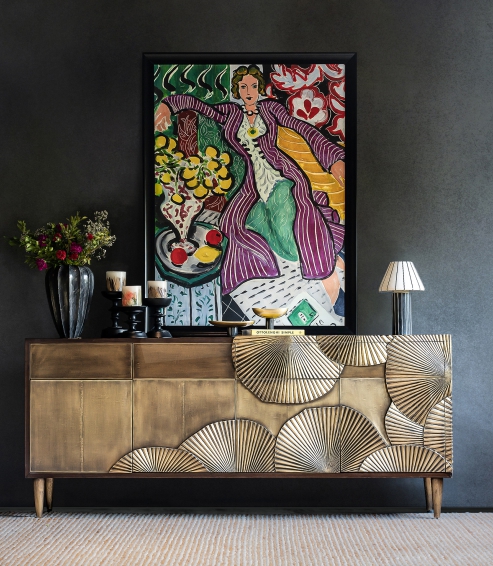We use cookies to make your experience better. To comply with the new e-Privacy directive, we need to ask for your consent to set the cookies. Learn more.
A PROSE IN ART
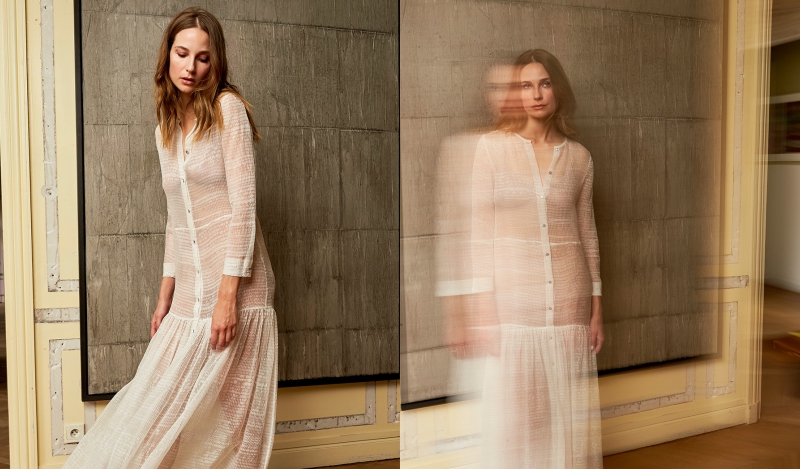
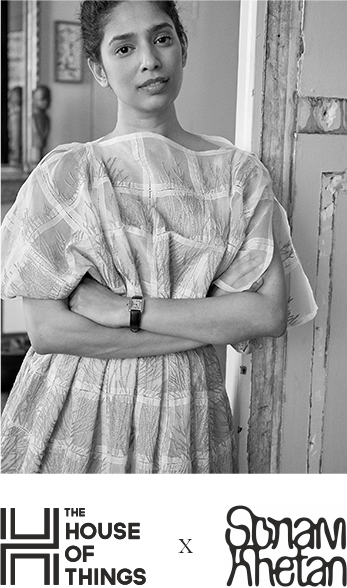

ABOUT SONAM KHETAN
“Fashion is more art than art is.”
- Andy Warhol
Some think of fashion as an industry, whereas others think of it as art, like a painting or sculpture. Coco Chanel famously said, “Fashion is not something that exists in dresses only. Fashion is in the sky, in the street; fashion has to do with ideas, the way we live, what is happening around us.” When it comes to fashion, it’s fair to say that designers draw ideas, materials, and patterns from other artistic crafts, as well as the environment.
Shaping the future of fashion, Paris and New Delhi-based Sonam Khetan is an Indian fashion designer with a unique and innovative approach to designing ecologically responsible creations that stand out. Her work is deeply rooted in nature; it is also about memory, culture, tradition, savoir-faire, and technology. Sonam dedicates a world of time researching on each concept and studying scientific findings and specialized publications for each collection. She is committed to creating timeless pieces that transcend the seasonal wearability of garments and fashion trends, inspired by the environment, for the environment.
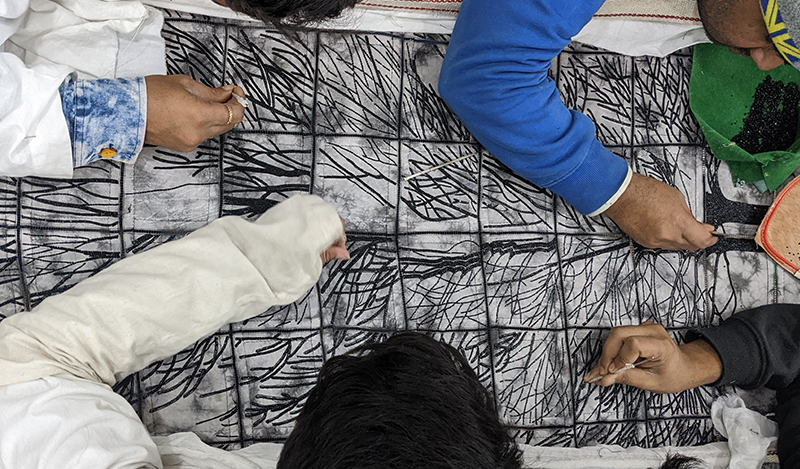

“My garments tell a story about the land, the forests, the rivers, the insects, and the species who share the Earth with us. I want to celebrate the beauty of the natural world, while also creating memories for future generations”, says Sonam.
Born in Udaipur, Sonam grew up in Bangalore and studied fashion in Paris. Sonam’s professional life began with fashion designer, and Woolmark Prize winner Rahul Mishra. She then worked as a textile designer for one of the biggest Indian textile companies, Himatsingka Seide Ltd., designing jacquards for American and European luxury home furnishing brands.
Sonam’s education at Central Saint Martin’s in London and Istituto Marangoni in Paris further enriched her professional life. She gained new experiences in fashion, including working at legendary luxury fashion house Balmain and with up-and-coming designers like Ludovic de Saint Sernin. In 2021, Sonam launched her luxury ready to wear label. Prioritizing eco-conscious design featuring contemporary, edgy, and elegant women’s ready-to-wear pieces made by hand in her atelier, the designer is inspired by ancient cultures and craftsmanship, as well as contemporary art.
Social and environmental happenings form an inherent core of her design process, where each garment is made with love by hand, sometimes starting from the first thread, and artisans pack in hours of their life and skill into it; a testament to that lies in the artisan’s hand embroidered signature borne on every piece.
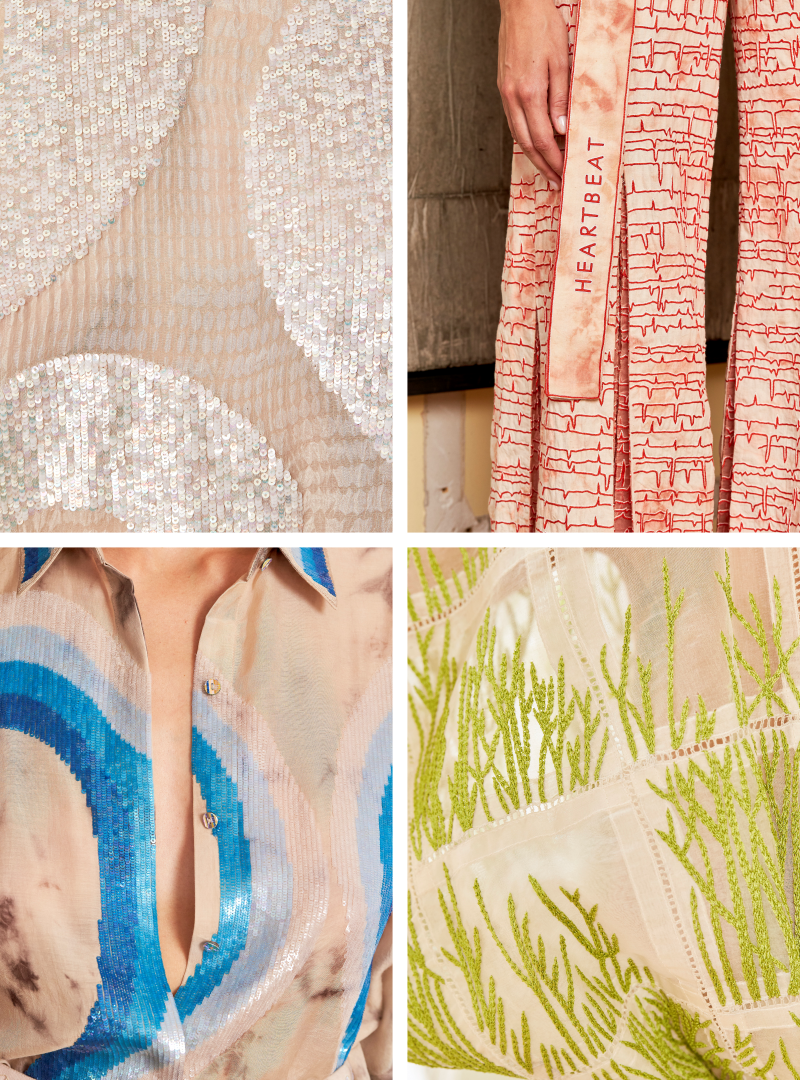

The brand focuses on the well-being of its makers and the environment as well as the health of its wearers. The fabrics are naturally hand-dyed by a women-owned artisanal studio, Adiv Pure Nature, in Mumbai, and an NGO, Aranya Naturals, in Kerala.
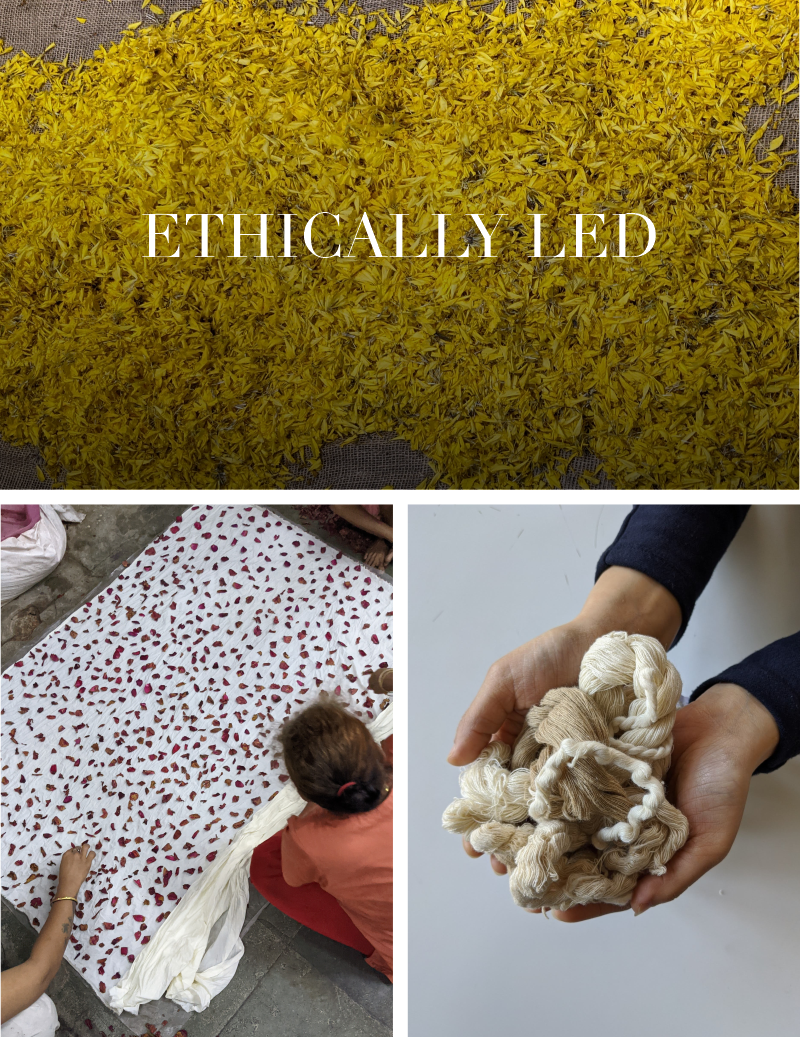

The conditions the plants used for dyeing grow in affects their colour, which makes each garment one-of-a-kind. The process requires careful placement of each flower by hand, to result in the deemed pattern.
Created with a deep concern for ecology, the brand uses fabrics that are natural and compostable, sourced locally from NGOs that employ local people, stores, textile mills, and indigenous craft clusters. By using naturally dyed fabrics, the brand ensures to safeguard the water bodies by minimizing waste and thereby protecting the health of the makers and the wearers.
Utilising age-old crafts like hand embroidery, natural weaving and dyeing techniques, fabric manipulation and hand sewing, Sonam creates garments that are each a work of art. Some of her garments are inspired by existing works by contemporary photographer Hiroshi Sugimoto – it tells of the environmental happenings around us – stories of the skies, forests, showers, and also the seeds being transported by winds and fireflies.


Snapshots of SS 23, “The Memory of Oceans”. The collection talks about solutions to rising temperatures and water levels. It also deals with the importance of preserving and planting mangroves. It focuses on biodiversity, tree migration, and an emphasis on every form of water body.
“The Memory of Oceans” collection throws light on critically endangered species and tree migration along with an emphasis on every form of water body – oceans, lakes, rivers, and icebergs. As the ice in the Arctic and Antarctic regions is melting faster, it is leading to more carbon release, global warming, and a rise in sea levels. The collection talks about solutions to these phenomena, the importance of preserving our mangroves, and propagating biodiversity.


The collection features hand embroidery inspired by the oceans. “Oceans absorb large amounts of heat and carbon dioxide from the atmosphere, serving as a critical buffer against climate change and keeping the world from otherwise becoming a practically unliveable hothouse. By some estimates the oceans have taken up about 25 percent of the excess carbon dioxide, and more than 90 percent of the excess heat, resulting from human activities since the 19th century”, explains Sonam.
Her work has been featured in Madame Figaro – France’s largest weekly fashion magazine and its website– madamefigaro.fr. She also has been the subject of digital creative platform @MADOfficiel.
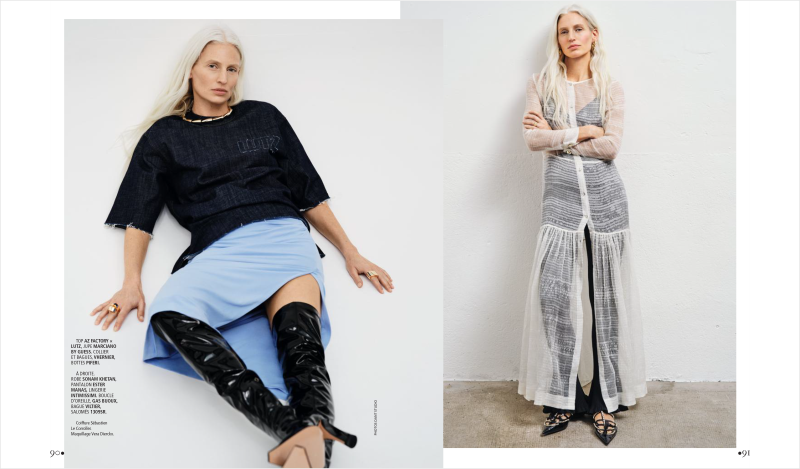



TAKE FIVE WITH SONAM KHETAN
We sat down with the visionary designer for a tête-à-tête about her exclusive collaboration with The House Of Things, the philosophy guiding her language, and the method behind her design process.
THOT: Tell us about your collaboration with The House Of Things, and how is it a perfect platform to host your pop-up…
SONAM KHETAN: I think the connection between THOT and my luxury ready to wear brand is that we each have a deep love and respect for craftsmanship and authenticity. We also connect through history. Each piece carries a lot of meaning, it comes with a history, it’s part of a chain of human creativity. Art is also a great connector between us. I am inspired by artists and THOT works with people who are real artists in their field.
THOT: How did you find your language in terms of design…what motivated you to create collections meant to raise environmental awareness and trigger action? Has that been a gradual evolution for you, or one specific thing that shocked you into action?
SONAM KHETAN: One’s language is an evolutionary process. Even great artists are not one day born all formed. Picasso started as coming from a classical tradition of painting and drawing. He did not start out as “Picasso” and he changed multiple times over time. I think the same process applies to every artist, designer, creative person. Anish Kapoor started by doing little installations with the colourful pigments he was surrounded by in India before moving to his huge sculptures. That’s how I see myself. I am where I am now and I will keep evolving, as we all do. I am very inspired by the way artists look at things. They have helped me push boundaries.
Environmental awareness and taking action, however small, has been a part of my life while growing up. It’s this part that I wanted to incorporate in my work. All my work is very influenced by ecology. That’s one of my main drivers. I would say it’s been a natural start of my work with ecology in my mind. However, there have been instances that have made my belief in my path stronger: The Rana Plaza catastrophe, which exposed the truth of fast fashion manufacturing and horrid treatment of people. Also, finding through my research that in ancient India, people used garments to heal themselves when they were sick. I am trying to raise awareness and inspire people through my collections to take action, through fashion or any other way that they can. Fashion is where I can act, for the moment.
THOT: Is there any designer/artist you feel whose work has inspired you?
SONAM KHETAN: Dries Van Noten. I love the richness of colors, the simplicity of the shapes, his emphasis on textures - his use of textiles as jacquards, prints, etc. And, as I have said, artists are a great source of inspiration for me, in particular Olafur Eliasson and Tomàs Saraceno, the Argentinian artist. Both are students of science, they combine science and art. Their process echoes in me. I love science and I do a lot of research with scientists, researchers before I start designing a collection. I strive to combine science and art with fashion.
Saraceno’s work with spiders, which he showed in 2018-2019 at the Palais de Tokyo, in Paris, featured the most delicate webs and the most resistant material in the world. Eliasson, I love how he creates precious objects with very little. I am inspired by his joyfulness, his generosity. I also love the communal eating in his Berlin studio, the sharing of vegetarian food with all those who work with him.
THOT: Your collection – The Memory of Oceans talks about the awareness of critically endangered species and tree migration with a focus on water bodies. How does it offer solutions to rising water levels and climate change?
SONAM KHETAN: Just the name of the collection is a way to open questions. Someone seeing “ocean memory” might be inspired to do some research and see that it exists and that it’s threatened by climate change. I am always struck by how different people, from different communities, from different parts of the world think of a solution to the same problem in very different ways. All actions start with awareness. I know that if people are aware, they will be inspired to take action. This action would come from many different thought processes, directions. And these solutions in my opinion, would be richer, as opposed to just one defined by my own point of view.
And that is why my main objective is to spread awareness at this point.
Nonetheless, I have listed a few simple actions that people could take in their everyday life.
THOT: Can you tell us a bit about your design process?
SONAM KHETAN: Every collection starts with extensive research by reading specialized publications, studying scientists and biologists works, trying to learn as much as I can about one specific topic related to ecology - oceans, for instance, or fires and their impact on tree migration, fog, etc.
I always connect every new collection with the previous one. This is a very important point for me. Each collection, in a way, builds on the previous one. There’s always a piece which creates this link between past and present collections. It also signifies how we are connected to our past and to each other, no matter how much time has passed.
Then I spend time looking at artists’ works - painters, photographers - how they talk about water, or the movement of trees, rain, etc. My design process starts with being aware of ecology and what part of ecology impacts us the most right now and what will impact us in future.
Finally, I start designing and sampling silhouettes, fabrics, embroideries and the colors that I want, the natural dyes, the techniques I want for the dyes.
You’ll find traces of my research and story throughout my collection.
THOT: Which is your most favourite piece from the collection, and why?
SONAM KHETAN: All of them! It’s a difficult question. It’s like asking a parent which is their favourite child. I love each of my pieces, but very differently and for different reasons which I cannot always explain. But if I really had to choose one piece, I would say: the Heartbeat suit. It’s the exact reproduction of my parents’ heartbeat. It’s what’s most precious to me.
THOT: Words such as ‘sustainability’ and ‘upcycling’ are being thrown around and are losing their meaning…is it challenging for you to communicate to your clients that your creations are environmentally sustainable?
SONAM KHETAN: Yes it is challenging! “Sustainability”, “upcycling”, “responsible” have all been overused. It’s human nature to abuse something when we see gains and profit in something. But these words also give visibility to an idea and that’s useful and is the need of the hour. I don't use the word “sustainability” because I think this is the way I naturally try to operate. I do my work, explain my story and allow people to see my work with an open mind and make their own inferences. When I create garments I want to be satisfied in my heart that no one in the chain, including the Earth, gets hurt or damaged. That authenticity is more important to me than using these words, or being labelled and put in a box. We're authentic and each season we try to improve, whether it's through pattern cutting methods, textiles, through raw materials like threads, buttons, embroidery materials, etc.
With platforms like The House of Things hosting us, we feel supported and seen in our mission. We can make a lot more people aware of things that they might not know or remind them of things which they already know. I am grateful to Astha for believing in me, supporting me and giving me this fantastic opportunity. She’s a powerhouse and an inspiration to all!


Read Similar
